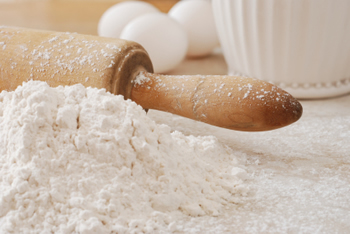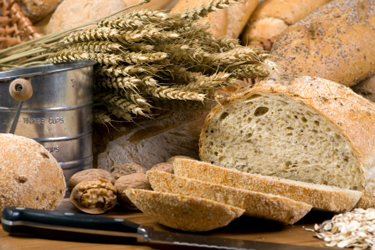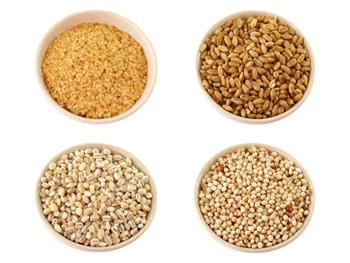Home > Home Milling > Flour Types
Types of Flour used to make bread
Flour is the primary ingredient in bread. The kind of flour used will determine the nature of the loaf. The better the flour, the better your bread will taste. Listed below are the main types of flour that can be used to make bread.

Wheat flours:
The main ingredient in most bread products. Wheat is rich in gluten, a protein that gives dough its elasticity and strength. When yeast and flour are mixed with liquid and then kneaded or beaten, the gluten forms and stretches to create a network that traps the carbon dioxide bubbles produced by the yeast.
Other Wheat Grains:
Breads made with whole wheat grains and whole wheat flour have a rich flavor as well as a coarse texture and dark brown color. If you prefer a lighter flavor, you can use white whole wheat flour. Breads made with white whole wheat have a sweeter taste and a pale golden color and a lighter texture. You’ll find this texture to be somewhere between the texture of whole wheat and white bread.

You can substitute Spelt, einkorn, emmer, and triticale flour for whole wheat flour in bread-baking recipes, but the texture will be a little bit different and the flavor will be deeper and richer.
By-products of milling white flours are unprocessed wheat bran and wheat germ. They add color, nutrition, and fiber to breads.

Wheat germ, Wheat Berries, Barley and Millet
Wheat Bran is the outer husk of the wheat, which is separated from the white flour during processing. Add a spoonful or two to your favorite recipe to provide extra fiber, texture and flavor. Or, substitute the wheat bran for part of the white bread flour.
Wheat Germ is the embryo or heart of the grain kernel. You can use it in its natural state or toast it for a nutty flavor.
Cracked Wheat is the whole wheat kernel, broken down into rather large pieces. The pieces are hard so it is best to soften them.
Bulghur Wheat is made from the grain of wheat. It is partially processed by boiling, which cracks the wheat kernel. You can add bulghur wheat to doughs to provide a crunchy texture.
Tips for using wheat grains
- Wheat germ increases the nutritional value of bread, but it also inhibits the gluten action. Do not use more than 2 tablespoons for every 2 cups of flour.
- To soften cracked wheat, simmer in hot water for 15 minutes, then drain and cool.
- You don’t have to cook bulghur before using in a recipe, but you might want to soften it by soaking it in water.
Mill your own wheat for flour
Freshly milled wheat is much sweeter than store-bought whole wheat flour and it tastes better.
Visit the home milling section to learn how to mill your own flour for nutritious and wholesome bread.
Non-wheat flours:
Such as millet and rice do not contain gluten so they must be mixed with a large proportion of wheat flour to make a traditionally shaped yeasted bread.
Read more about non-wheat flours.
Sources:
Copyright © 2007 – ACH Food Companies, Inc. All rights reserved.
www.FLOUR.com
www.thewondermill.com
Copyright 2005. U.S. Wheat Associates. All Rights Reserved.
Hensperger, Beth. Bread Made Easy – A Baker’s First Bread Book. Ten Speed Press 2000.
Shapter, Jennie. Bread Machine – How to prepare and bake the perfect loaf. Hermes House 2003.

pauline mc donagh says
what is the best flour to use for brown bread
Cathy says
Brown bread is typically made with wholemeal (whole wheat) flour.
Daniel M Bleskey says
I really depends on what you mean by brown bread. I make a dark German Rye that some of my friends say is similar to “Squaw Bread”. This is Rye Recipe uses Molasses and is a very deep dark brown.
Red hard wheat as well as rye are used in my mill and produce a rustic, artisan type loaf. This is more akin to the darker “wheat” breads found in supermarkets.
Hope this helps.
mamatha says
Can we use almond flour to make bread??
Cathy says
Almond flour can be used in bread, but it is gluten free so you would need to mix it with other flours to provide structure.